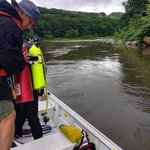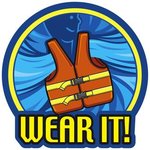 Narrowsburg
NarrowsburgLight Rain Fog/Mist, 43°
Wind: 8.1 mph
 Narrowsburg
NarrowsburgRIVERS EVERYWHERE — If there is only one thing that you do to keep yourself safe on the river, wear a lifejacket. If you want to add extra protection and made your jaunts in the river more …
Stay informed about your community and support local independent journalism.
Subscribe to The River Reporter today. click here
This item is available in full to subscribers.
Please log in to continue |


RIVERS EVERYWHERE — If there is only one thing that you do to keep yourself safe on the river, wear a lifejacket. If you want to add extra protection and made your jaunts in the river more comfortable, put on some river shoes. If you want to be more relaxed when you get off the river, wear a hat and sunscreen.
These are simple things. They make your river trip safe and enjoyable. And it makes it less likely that you will need assistance from the river emergency services team that will be called if you get into trouble.
One of those teams is the Sullivan County Dive and Rescue Team. Made up of members from area volunteer fire departments, the dive team comprises trained and certified divers, and a support staff that includes tenders and profilers.
Here’s how it goes.
The dive team is called to a scene by the local emergency department, either a fire department, ambulance corps or the county sheriff’s department. Generally, if it’s a rescue, fire departments will respond first to the scene with a watercraft to help stranded boaters or swimmers. When the emergency call moves from a rescue to a recovery, the dive team is called.
Upon arrival, the incident commander will establish the point last seen by interviewing witnesses. This helps the commander and the dive team captain develop a plan of action to search either from the shore or from a boat positioned upstream of the point last seen.
Search patterns are established, prioritizing the point last seen and identifying obstacles on the river that might provide a catch point.
Three divers get ready: the primary diver, the backup and the 90-percent ready. The backup diver is available immediately should the primary diver get into trouble.
Each diver is tethered by a rope and a tender is positioned either on the boat or the shore. The tender, who is in constant communication with the diver, uses a series of signals to guide the diver on the methodical and established search pattern. A profiler tracks the divers’ breathing rate by using a stopwatch and watching the bubbles that come to the surface. With that information, they can determine the amount of air left in their tanks.
The divers crawl along the bottom, reaching out in both directions, covering a five-foot swatch. When they get to the edge of the search area, they are signaled, and keeping one hand on the river bottom, they turn and search back in the other direction, five feet farther downstream. Each diver works for 30 minutes before being replaced by a new diver.
When the body is found, extreme caution and respect are used to retrieve the body.
This summer there have been six drownings. Not one of those drowned people was wearing a properly fitted lifejacket. Five of the accidents were swimming-related.
The Upper Delaware is a beautiful river, made even more so by following safety precautions.
River safety is simple: Wear a lifejacket and foot coverings.
For more river information, visit www.nps.gov/upde.
Comments
No comments on this item Please log in to comment by clicking here